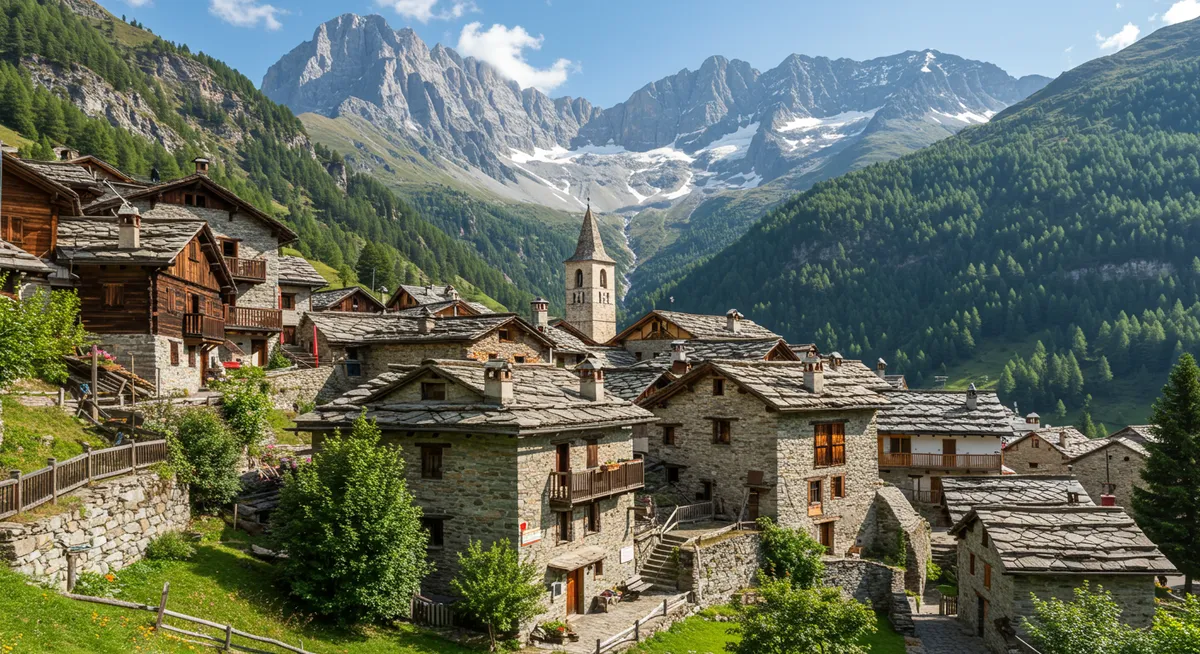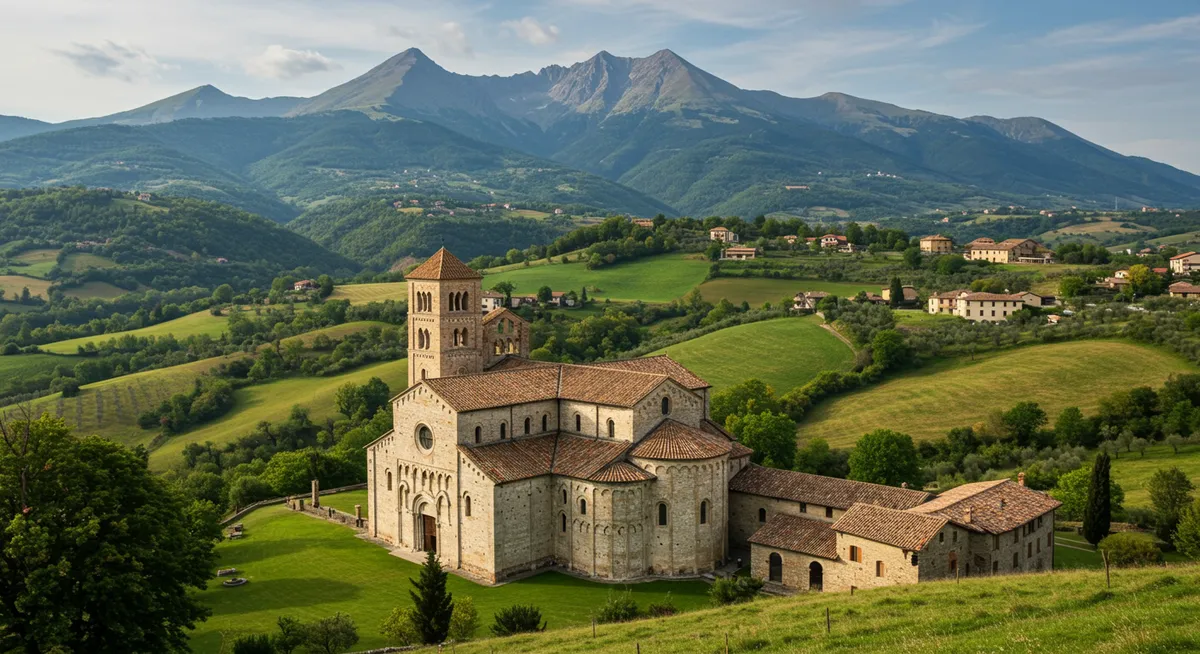Historic Mountain Villages in the Italian Alps

Historic Mountain Villages in the Italian Alps
Italy's northern mountain regions harbor extraordinary historic settlements that showcase the unique architectural traditions and cultural heritage of Alpine communities. These remarkably preserved villages, nestled in dramatic valleys or perched on precipitous slopes, developed distinctive building styles and social structures shaped by their challenging environments. From stone hamlets that appear unchanged since medieval times to pristine wooden settlements influenced by Germanic and Alpine traditions, these mountain communities offer authentic glimpses into centuries of Alpine life, all set against the breathtaking backdrop of Europe's most iconic mountain range.

1. Chianale: Medieval Stone Gem of Piedmont
Nestled high in the Valle Varaita near the French border in Piedmont, Chianale stands as one of Italy's most perfectly preserved medieval mountain villages. At an elevation of 1,797 meters (5,896 feet), this extraordinary stone settlement represents the pinnacle of Alpine architectural adaptation, with its tightly clustered stone houses, narrow passages, and distinctive slate roofs designed to withstand harsh mountain winters. Recognized as one of Italy's "Borghi più belli d'Italia" (Most Beautiful Villages), Chianale offers visitors an authentic journey into medieval mountain life seemingly untouched by centuries of progress.
What Makes It Special
- Stone Mastery: Features extraordinary examples of Alpine stone construction, with houses built from locally quarried stone and slate
- Architectural Integrity: Maintains a remarkably complete medieval appearance with minimal modern intrusions
- Occitan Heritage: Preserves the distinct Occitan culture and language found in this cross-border region
- Alpine Adaptation: Buildings demonstrate perfect adaptation to extreme mountain weather, with compact forms and strategic positioning
Historic Significance
Chianale's history traces back to medieval times when it developed as a strategic settlement controlling the Colle dell'Agnello pass between Italy and France. The village became an important stop on trading routes connecting the Po Valley with Provence, while also supporting a self-sufficient mountain economy based on agriculture and livestock. The distinctive stone architecture evolved as a practical response to the harsh Alpine environment, using locally available materials and construction techniques passed down through generations. The village's remote location and economic marginalization in modern times helped preserve its medieval character, making it one of the most authentic historic settlements in the western Alps.
What to Experience
Wander the narrow stone passageways between tightly packed houses, noting the distinctive covered wooden balconies (lobbie) used for drying agricultural products. Visit the 15th-century Parish Church of Sant'Antonio with its remarkable wooden altar and medieval frescoes. Explore the Museo della Civiltà Alpina (Museum of Alpine Civilization) showcasing traditional tools, crafts, and daily life in historic mountain communities. Discover examples of the distinctive stone ovens built outside homes to reduce fire risk in the densely built village. Hike the ancient trails connecting to nearby hamlets and Alpine pastures still used for summer grazing.

2. Soglio: Italian Village with Swiss Soul
Perched dramatically on a sunny terrace high above the Val Bregaglia in Italy's northernmost Lombardy region, Soglio embodies the unique cross-cultural heritage of the Alpine borderlands. Though administratively in Switzerland today, this extraordinarily preserved village showcases the distinctive architectural and cultural traditions that developed in Italian-speaking valleys under Swiss influence. Famously described by painter Giovanni Segantini as "the gateway to paradise," Soglio offers spectacularly framed views of the Sciora and Badile peaks, alongside a perfectly preserved historic center with granite palazzi and humble mountain dwellings coexisting in remarkable harmony.
What Makes It Special
- Dramatic Setting: Occupies a south-facing mountain terrace with panoramic views of some of the Alps' most spectacular peaks
- Cultural Crossroads: Showcases unique Italian-Swiss architectural traditions with both palatial buildings and humble rural structures
- Palazzo Salis: Contains the impressive 16th-century noble residence with its baroque garden, once the seat of the powerful Salis family
- Agricultural Landscape: Surrounded by terraced fields, chestnut groves, and traditional agricultural systems still in use today
Historic Significance
Soglio's history reflects the complex political and cultural configurations of the Alpine border regions. The village first appears in historical records in 1186 and developed as part of the Three Leagues federation that later joined Switzerland. Despite its political affiliation, the village maintained strong cultural and linguistic ties to Italy. The powerful von Salis family established their residence here in the 16th century, bringing sophisticated architectural influences while the village continued to function as an agricultural community. Soglio's remarkable preservation stems from both its relative isolation and conscious conservation efforts that began in the early 20th century as the village was discovered by artists and early Alpine tourists.
What to Experience
Explore the perfectly preserved village center with its narrow cobblestone streets and distinctive mix of noble and rural architecture. Visit the 13th-century Church of San Lorenzo with its onion-domed bell tower reflecting northern Alpine influences. Tour the Palazzo Salis (now a hotel) with its baroque garden and historic rooms containing original furnishings and paintings. Discover the traditional chestnut processing facilities that supported the village economy for centuries, including drying rooms and mills. Hike the ancient mule paths and agricultural terraces surrounding the village that have remained largely unchanged for centuries.

3. San Pietro in Valle: Monastic Village in the Clouds
Hidden in the misty mountains of central Italy's Umbria region, San Pietro in Valle represents one of Italy's most remarkable combinations of historic monastic complex and mountain village. This extraordinary settlement, centered around a powerful Benedictine abbey founded in the 8th century, occupies a dramatic position in the remote Nera River Valley. The site encompasses a magnificent Romanesque church containing important early medieval frescoes, a well-preserved monastic complex, and a small cluster of stone buildings that grew around the religious center, all set against a backdrop of forested mountains and dramatic gorges.
What Makes It Special
- Magnificent Abbey: Features one of Italy's most important early medieval monastic complexes with exceptional Romanesque architecture
- Artistic Treasure: Contains remarkable 12th-century frescoes representing one of the most complete cycles of Romanesque wall painting in Italy
- Remote Setting: Occupies an isolated mountain location that has preserved both the architecture and spiritual atmosphere
- Longobard Heritage: Founded by Longobard Duke Faroald II, representing this important period in Italian history
Historic Significance
According to tradition, San Pietro in Valle was founded in 720 CE by Faroald II, Duke of Spoleto, who retired here as a monk after being deposed by his son. The abbey quickly became an important spiritual and political center in the Longobard territories, receiving extensive donations and privileges. The current church dates primarily from the late 11th-century reconstruction in Romanesque style, with the remarkable fresco cycle completed in the 12th century. The abbey maintained its importance through the medieval period before gradually declining after the 15th century. Unlike many similar complexes, it escaped complete abandonment and destruction, maintaining its artistic and architectural integrity into the modern era.
What to Experience
Marvel at the exceptional cycle of 12th-century frescoes in the abbey church, depicting scenes from the Old and New Testaments in vivid Romanesque style rarely preserved so completely. Explore the perfectly proportioned Romanesque church with its harmonious architectural elements and ancient Roman columns reused from earlier structures. Visit the atmospheric monastic complex, now sensitively converted into accommodation that maintains the historic character. Wander the small cluster of stone buildings that grew around the abbey, constructed in the distinctive mountain style of central Italy. Hike the ancient paths connecting to nearby hermitages and natural features that added to the site's sacred geography.

4. Chamois: Italy's Highest Carless Village
Perched at an elevation of 1,815 meters (5,955 feet) in Valle d'Aosta, Chamois holds the distinction of being Italy's highest commune without road access. This remarkable Alpine village, reachable only by cable car or footpath, has preserved its historic character and traditional mountain architecture largely due to this splendid isolation. Stone and wooden chalets with distinctive roof structures cluster around ancient fountains and a historic parish church, while surrounding Alpine meadows host traditional agriculture and livestock practices that have continued for centuries, creating an authentic mountain community seemingly untouched by modern development.
What Makes It Special
- Car-Free Environment: The only commune in Italy entirely without road access, preserving traditional mountain atmosphere
- Traditional Architecture: Features excellent examples of Valle d'Aosta mountain building traditions combining stone and wood
- Active Mountain Economy: Maintains traditional Alpine agricultural practices with working farms and summer pasturing
- Franco-Provençal Heritage: Preserves the distinctive language and cultural traditions of this Alpine minority
Historic Significance
Chamois has been continuously inhabited since at least the 14th century, developing as a self-sufficient mountain community based on Alpine agriculture and livestock raising. Its extreme elevation and difficult access created a necessity for self-reliance, with residents developing specialized agricultural techniques adapted to the short growing season and harsh winter conditions. The village's architecture evolved to address these challenges, with sturdy stone ground floors for animals (providing natural heating for upper levels), wooden upper stories for human habitation, and distinctive roof structures designed to handle heavy snow loads. Unlike many similar settlements that were abandoned as mountain agriculture declined, Chamois successfully transitioned to sustainable tourism while maintaining its traditional character.
Exploring the Italian Alpine Villages
These historic mountain villages offer a journey through Italy's diverse Alpine heritage, with each showcasing unique adaptations to mountain life. Consider these themed itineraries for your exploration:
- Piedmont Alpine Route: Begin at Chianale and explore other historic villages in the Piedmont region, including those in the nearby Valle Maira and Valle Stura
- Cross-Border Exploration: Visit Soglio and other villages in the Italian-Swiss borderlands to experience the unique cultural fusion of these Alpine regions
- Spiritual Mountain Journey: Combine San Pietro in Valle with other historic monasteries and religious sites in the central Italian mountains
- Car-Free Alpine Experience: Experience Chamois and other remote villages accessible only by foot or cable car for an authentic mountain adventure
Travel Tip: The ideal seasons to visit these Alpine villages are late spring (June) when wildflowers carpet the meadows, and early autumn (September) when the forests display vibrant colors and local harvest festivals take place. Winter visits offer a magical snow-covered experience but require proper preparation for mountain conditions.
Related Content
If you're fascinated by Italy's historic mountain villages, you might also enjoy these related articles:

7 Underrated Medieval Villages in Italy You'll Love
Discover Italy's best-kept secrets - charming medieval villages off the tourist trail that offer authentic Italian experiences.

10 Best Preserved Medieval Villages in France
Discover France's most breathtaking medieval villages, from the perfectly preserved streets of Pérouges to historic Carcassonne.

Lesser-Known Villages in the Swiss Alps
Discover enchanting Alpine villages in Switzerland that offer authentic experiences and breathtaking mountain scenery.
Explore More Historic & Hidden Gem Villages
Discover more extraordinary villages across Europe and beyond.